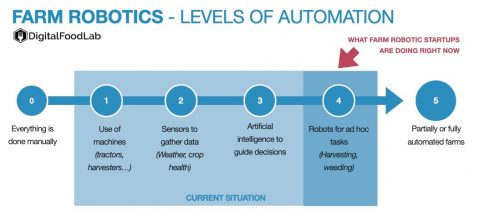Last week, I was doing a talk on how robots can help us imagine the future of food. Robots have been inside factories for decades, but the level of automation in the food industry remains low compared to other sectors. One of the categories with the most active ecosystem of startups working around robots is agriculture.
Why do we need robots?
Robots were not considered a viable opportunity in agriculture for decades. Indeed, beyond their cool factor, robots tend to be really expensive and require maintenance from highly qualified people. This and the availability of an almost infinite pool of cheap (often immigrant) workforce limited their progress. However, things are changing fast as:
- during COVID-related lockdowns, immigrants were not allowed to cross borders, and many farms (notably in the US) could not hire enough people for the harvests.
- food companies and retailers are keener to pay a premium to have more sustainable and dependable sources of produce, ideally located closer to the place of consumption.
Combined, these factors make farm robots more interesting. If they are still not deployed massively, farmers are much more enthusiastic about experimenting with them at scale.

What do we mean by farm robotics?
Interestingly, compared to other categories of the food value chain, agriculture is already heavily mechanised (with tractors), and many farmers use multiple sensors and devices to predict the health of their crops or livestock. This is notably due to the rise of precision farming startups.
For the past decade, we have observed the slow but steady rise of an ecosystem of startups working on robots that can perform ad hoc tasks such as:
- spraying with drones or small robots which, combined with machine learning (to analyse the health of each plant), can reduce the amount of pesticides used.
- weeding with larger robots to replace humans in one of the most demanding tasks, such as Farmwise, which raised $45M this month.
- harvesting: this is maybe the most difficult of all the tasks that can be asked of robots due to fruits and vegetables’ fragility and diversity (example: Traptic, acquired by Bowery, a vertical farming startup earlier this year)

Where is this going?
As often with agriculture, we can wonder if these innovations to increase the productivity and sustainability of current farms are not the first steps toward a very different future. Indeed, the combination of robots and artificial intelligence to guide the decisions of the farm (in terms of which type of product to spray or which crop to plant) could lead toward partially or fully automated farms. This is already the case in some vertical farms, which are highly automated and make extensive use of robots.
The future of food will be more automated. If this is to happen, it will startup with the massive utilisation of robots in agriculture. This is something that all agrifood businesses should keep an eye on as it will reshape the way we think about our food.







